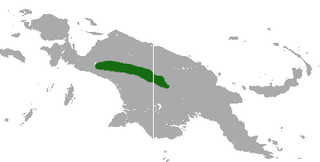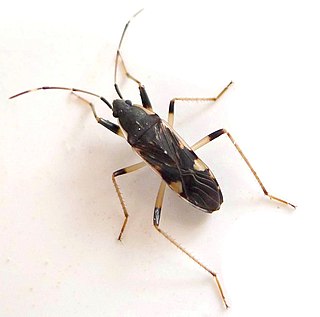
The sugar glider is a small, omnivorous, arboreal, and nocturnal gliding possum. The common name refers to its predilection for sugary foods such as sap and nectar and its ability to glide through the air, much like a flying squirrel. They have very similar habits and appearance to the flying squirrel, despite not being closely related—an example of convergent evolution. The scientific name, Petaurus breviceps, translates from Latin as "short-headed rope-dancer", a reference to their canopy acrobatics.
The distinguished Oldfield mouse is a species of rodent in the family Cricetidae. It is found only in Peru.

The black-headed siskin, also known as the Jonny Bee, is a species of finch in the family Fringillidae. It is found in Mexico, Belize, El Salvador, Guatemala, Honduras, and Nicaragua. Its natural habitats are subtropical or tropical moist montane forest and heavily degraded former forest.

The blackstripe topminnow, Fundulus notatus, is a small freshwater fish in the family Fundulidae, found in central North America.
The common forest tree frog is a species of frog in the family Arthroleptidae found in Angola, Cameroon, the Republic of the Congo, the Democratic Republic of the Congo, Equatorial Guinea, Gabon, Nigeria, and possibly the Central African Republic. Its natural habitats are subtropical or tropical moist lowland forest, subtropical or tropical moist montane forest, subtropical or tropical high-altitude grassland, rivers, intermittent freshwater marshes, and heavily degraded former forests.
The yellow-lored bristlebill or lesser bristlebill is a species of songbird in the bulbul family, Pycnonotidae. It is found in central Africa.

The speckled rail, also called speckled crake, is a species of bird in subfamily Rallinae of family Rallidae, the rails, gallinules, and coots. It is found in Argentina, Brazil, Guyana, Paraguay, Uruguay, and Venezuela.

The Malagasy green sunbird, also known as the long-billed green sunbird, is a species of bird in the family Nectariniidae. It has been placed in the genus Nectarinia. It is found in the Comoros and Madagascar. Its natural habitats are subtropical or tropical dry forest, subtropical or tropical moist lowland forest, subtropical or tropical mangrove forest, and subtropical or tropical moist montane forest.

The ear-spot squirrel is a species of rodent in the family Sciuridae. It is endemic to Borneo and is diurnal and active mainly in small trees. It closely resembles the plantain squirrel, but is smaller and with a distinct pale buffy patch behind each ear.

The plantain squirrel, oriental squirrel or tricoloured squirrel is a species of rodent in the family Sciuridae found in Indonesia, Malaysia, Singapore, and Thailand in a wide range of habitats: forests, mangroves, parks, gardens, and agricultural areas. Fruit farmers consider them to be pests.
Epigrapsus is genus of terrestrial crabs. The two species are omnivores.

Sphaerodactylus notatus, also known as the Floridareef gecko or brown-speckled sphaero, is a small species of gecko native to Florida and the Caribbean.

Synodontis notatus, known as the onespot squeaker, the one-spot synodontis, or the domino syno, is a species of upside-down catfish native to the Congo Basin of the Democratic Republic of the Congo, and the Republic of the Congo. It was first described by French zoologist Léon Vaillant in 1893. The specific name "notatus" comes from the Latin word for "marked", as with a spot.

Seri's tree-kangaroo is a species of tree-kangaroo native and endemic to montane forests of west-central New Guinea. Seri's tree-kangaroo was originally considered to be a subspecies of Dendrolagus dorianus, but was elevated to species in 2005 by Groves.

Dendrolagus notatus, the ifola or ifola tree kangaroo, is a species of marsupial in the family Macropodidae. It is endemic to Papua New Guinea where it is found in high elevations of the central mountains. It is threatened by habitat loss and hunting for food with dogs by local people. The species is usually considered a subspecies of Dendrolagus dorianus but has recently been considered as a separate species by Helgen in 2007.

The bluntnose minnow is a species of temperate freshwater fish belonging to the genus Pimephales of the cyprinid family. Its natural geographic range extends from the Great Lakes south along the Mississippi River basin to Louisiana, and east across the Midwestern United States to New York State. The bluntnose is very ubiquitous, and may be the most common freshwater fish in the Eastern U.S.

Porichthys notatus is a species of batrachoid toadfish. It is a member of the midshipman genus, Porichthys, and is known by the common name plainfin midshipman. It is native to the eastern Pacific Ocean, where its distribution extends along the coast from Sitka, Alaska, to Magdalena Bay in southern Baja California.

Stylurus notatus, the elusive clubtail, is a species of clubtail in the family of dragonflies known as Gomphidae. It is found in North America.

Dieuches is a genus of dirt-colored seed bugs in the family Rhyparochromidae. There are more than 130 described species in Dieuches.
Hisonotus notatus is a species of catfish in the family Loricariidae. It is a freshwater species native to Brazil, where it occurs in the São João River and other coastal drainages of the stae of Rio de Janeiro. It reaches 4.3 cm SL and is the type species of the genus Hisonotus. It was formerly considered conspecific with Hisonotus thayeri, but a 2016 revision by Fernanda Martins and Francisco Langeani redescribed H. notatus and adopted the new name H. thayeri to some populations formerly classified as H. notatus.















